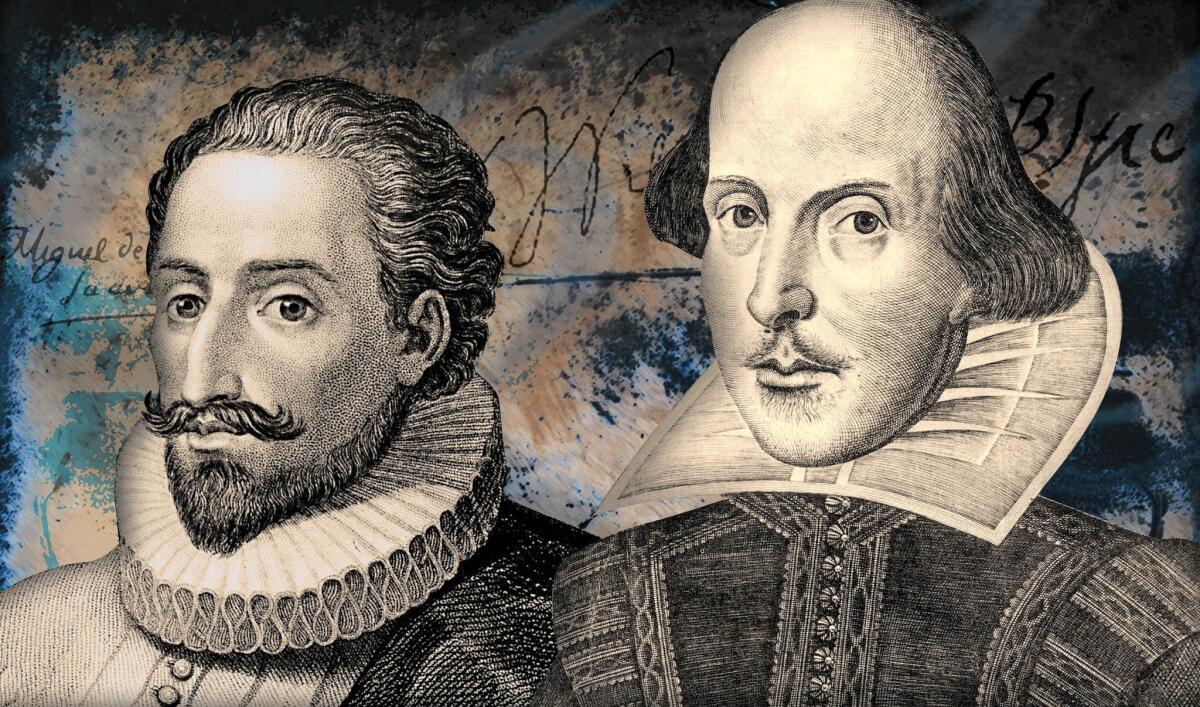The secret connection between Cervantes and Shakespeare

Miguel de Cervantes, left, and William Shakespeare set the course of literary history - and died the same day.
- Share via
As if neither man wanted to live in a world without the other, Miguel de Cervantes and William Shakespeare died on the same date in 1616.
Or not exactly. They didn’t actually succumb on the same day. Shakespeare and Cervantes probably died or were buried almost a fortnight apart, mostly because Catholic Spain preferred the Gregorian calendar, which ran 11 days behind Protestant England’s.
Still, each writer died around what he thought of as April 23, so April 23 it is. As Hamlet says, “Thinking makes it so.” Or, to paraphrase Quixote, your windmill is my giant. And people say Einstein discovered relativity.
What really matters about these two men isn’t their mortal longevity, naturally, but their gift to us, an inexhaustible bounty so abundant that all their contemporaries fade into footnotes beside them. (After Cervantes, nobody wrote another half-decent novel till “Robinson Crusoe” in 1719.) What a shame that Cervantes and Shakespeare never met to talk a little shop, tell a dirty joke, perhaps even collaborate.
Or didn’t they?
Puckish writers have advanced more than one theory by which Shakespeare (born in 1564, same year as Galileo) and Cervantes (the late bloomer, born in 1547, in his 50s as begins the “Quixote,” formally, “The Ingenious Gentleman Don Quixote of La Mancha”) might once have crossed paths. Spain and England were fighting an undeclared war at the time, which makes finagling the pair into the same room together only that much more fun.
A favorite scenario takes place during Shakespeare’s “missing years,” between 1585 and 1592. Vivid imaginations have speculated that Shakespeare might have traveled to Spain somewhere in there — perhaps shortly before the defeat of the Armada in 1588 — to spy for the British crown.
Of course, just because literary historians can’t find anything to do with those lost seven years doesn’t mean Shakespeare couldn’t. If you want to define “missing” as leaving no trace 400 years later, somebody send out a search party for my life.
To contrive some sort of collaboration between Shakespeare and Cervantes, literary matchmakers could have skipped all their needy, rococo chess moves. Instead, they could do worse than to look at an unloved old play called “Double Falsehood; or The Distressed Lovers.”
It all starts in 1612, when an educated, bilingual, actual Irish spy named Thomas Shelton translates part one of the “Quixote” — to rapturous acclaim and sensational sales — as “The History of the Valorous and Wittie Knight-Errant Don-Quixote of the Mancha.” About a year later, an aging William Shakespeare and his anointed protege, John Fletcher, co-write their third play together, “The History of Cardenio.” That would be the same crazed, cuckolded Cardenio whom Don Quixote met in Chapter 23 of the novel, then helped reunite with his inamorata a hundred pages later.
Yes, as the wittie Ring Lardner might have said, you could look it up. In 1613, almost surely without ever meeting in person, it was Shakespeare who helped usher Cervantes onto the British stage for the first time.
Or so we think. Shakespeare’s Globe Theatre burned down around this time, and Fletcher and Shakespeare’s “Cardenio” went unpublished and unrevived in any documented form until 1727. That’s when a top-flight Shakespeare scholar and middling playwright named Lewis Theobald supposedly re-adapted and “improved” “Cardenio” into “Double Falsehood.” Theobald claimed he’d worked from three “Cardenio” manuscripts, which later wound up in the Covent Garden Theatre museum. We’ll never know, because in 1808 Covent Garden Theatre burned down too.
But to recap: “Double Falsehood” is purported to be a rewrite by Theobald of the lost play “The History of Cardenio,” co-adapted by Shakespeare and Fletcher from a beloved but iffy translation of Don Quixote. By a spy.
Got that? Trust it? The whole story is all richly, byzantinely, humanly complicated enough to make the “Quixote,” which Cervantes himself playfully passed off as a translation from the work of a fictitious Moorish historian, look like what it arguably is: the first realistic novel.
So is “Double Falsehood” any good? It’s no “King Lear,” that’s for sure, though only one play I can think of is. Even on its merits, Theobald’s alleged pastiche of Cervantes by way of Shakespeare can tax a reader’s patience. Earthbound, repetitive, with sexual politics from beyond Mars, the drama suspends disbelief by its thumbs and then tickles it into incontinence.
Yet you can see why it worked. To my eye, Shakespeare’s corrupted DNA still coils inside, curled idiosyncratically around his co-author Fletcher’s, squeezing every drop of pulpy melodrama out of Cervantes’ original Cardenio chapters.
For some circumstantial, pseudo-biographical evidence, look no further than the story’s first moments. In the version Theobald adapted, however attenuatedly, from Shakespeare and his apprentice, the story begins with an aged duke pondering the estate he’s passing on to his son: “I’ve worn the garland of my honours long/And would not leave it wither’d.” Might the most honored playwright of his day and ours already have suspected that Fletcher, while eventually prolific and really not half bad, was no Shakespeare and never would be?
By contrast, Cervantes starts his original by introducing us to Cardenio, a wandering lunatic whom Don Quixote inexplicably embraces “como si de luengos tiempos le hubiera conocido”; that is, as if Quixote had known him for ages. Even more mysteriously, our knight-errant then proceeds to emulate Cardenio, consciously feigning insanity — as if Quixote weren’t nuts enough already. For Cervantes, then, Cardenio’s tale becomes one of shared madness, the contagious, crackpot invention that makes all comedy, and all love, possible.
Critical interpretation like this is a mug’s game, of course, doomed as any misbegotten fan’s attempt to corral Cervantes and Shakespeare into the same frame. Even if these titans had tried somehow to meet up for a beer, they’d have gotten their calendars mixed up and missed each other by 11 days anyway.
And yet we can’t help wishing otherwise. Have you heard the one about the two dead European guys with beards who walk into a bar at the turn of the 17th century?
So the first one says, “Let’s you and me have a drink and invent modern literature.”
The second one answers, “OK, but the better writer’s buying.”
First one says, “How do we know which one of us is better?”
And the second one says, “I’ve heard the good die young. Whoever dies first is better.”
Founder of the nonprofit Boyle Heights lending library Libros Schmibros, David Kipen has translated Cervantes’ novella “The Dialogue of the Dogs” (Melville House, 2008) and is working on the Pablo Neruda play “The Passion of Joaquin Murieta.” He teaches on UCLA’s Writing Programs faculty and writes about California.
::
Critics at large
In an ongoing series, our 10 critics at large consider books, reading and our culture. In this essay, former N.E.A. director of literature David Kipen looks at the unknown connections between Cervantes and Shakespeare.
More to Read
Sign up for our Book Club newsletter
Get the latest news, events and more from the Los Angeles Times Book Club, and help us get L.A. reading and talking.
You may occasionally receive promotional content from the Los Angeles Times.










